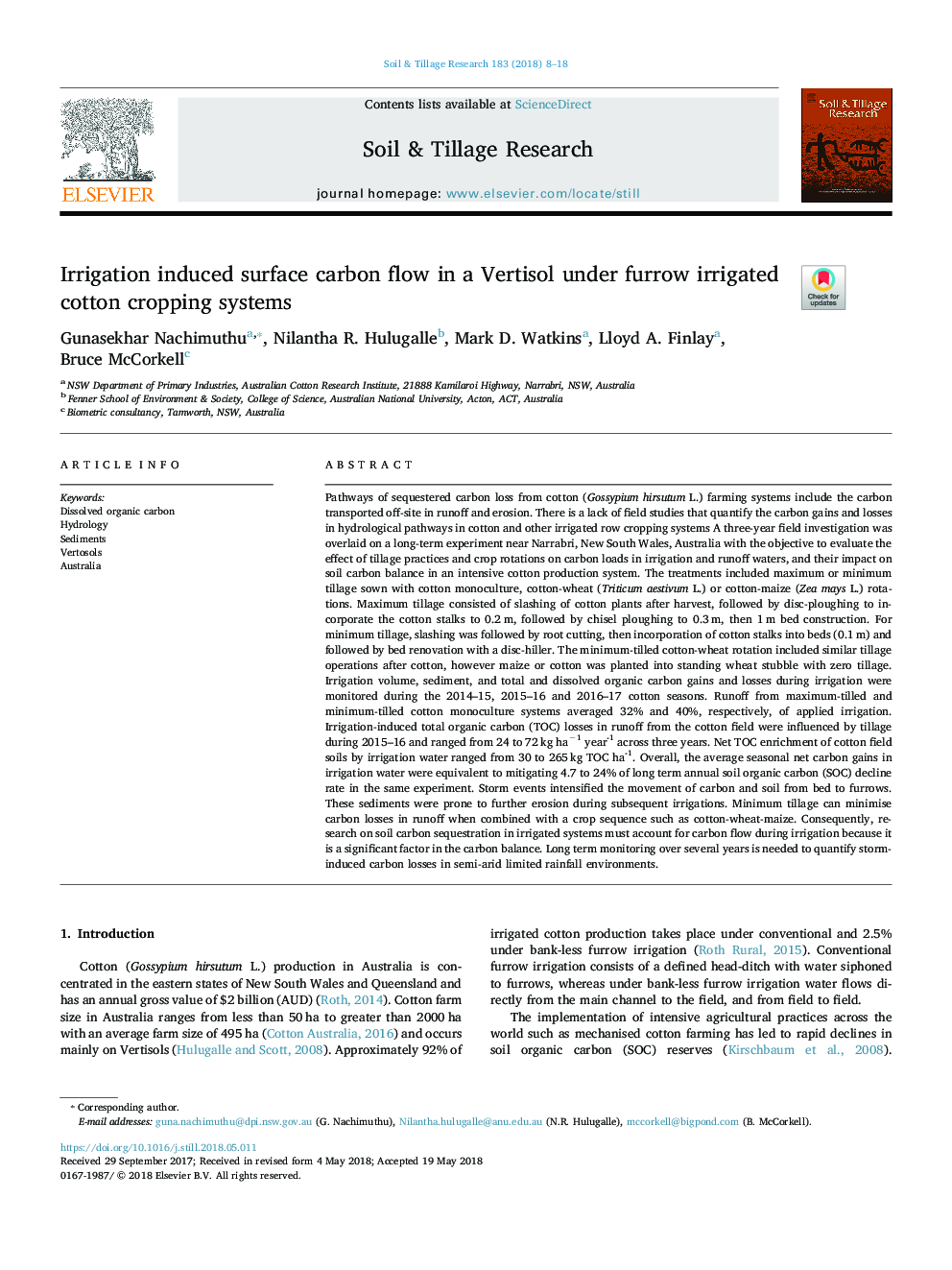| کد مقاله | کد نشریه | سال انتشار | مقاله انگلیسی | نسخه تمام متن |
|---|---|---|---|---|
| 6772900 | 1431820 | 2018 | 11 صفحه PDF | دانلود رایگان |
عنوان انگلیسی مقاله ISI
Irrigation induced surface carbon flow in a Vertisol under furrow irrigated cotton cropping systems
ترجمه فارسی عنوان
آبیاری موجب ایجاد جریان کربن سطحی در ورتسول تحت سیستم های کشت محصولات کشاورزی آبی شده می شود
دانلود مقاله + سفارش ترجمه
دانلود مقاله ISI انگلیسی
رایگان برای ایرانیان
کلمات کلیدی
موضوعات مرتبط
مهندسی و علوم پایه
مهندسی انرژی
انرژی های تجدید پذیر، توسعه پایدار و محیط زیست
چکیده انگلیسی
Pathways of sequestered carbon loss from cotton (Gossypium hirsutum L.) farming systems include the carbon transported off-site in runoff and erosion. There is a lack of field studies that quantify the carbon gains and losses in hydrological pathways in cotton and other irrigated row cropping systems A three-year field investigation was overlaid on a long-term experiment near Narrabri, New South Wales, Australia with the objective to evaluate the effect of tillage practices and crop rotations on carbon loads in irrigation and runoff waters, and their impact on soil carbon balance in an intensive cotton production system. The treatments included maximum or minimum tillage sown with cotton monoculture, cotton-wheat (Triticum aestivum L.) or cotton-maize (Zea mays L.) rotations. Maximum tillage consisted of slashing of cotton plants after harvest, followed by disc-ploughing to incorporate the cotton stalks to 0.2â¯m, followed by chisel ploughing to 0.3â¯m, then 1â¯m bed construction. For minimum tillage, slashing was followed by root cutting, then incorporation of cotton stalks into beds (0.1â¯m) and followed by bed renovation with a disc-hiller. The minimum-tilled cotton-wheat rotation included similar tillage operations after cotton, however maize or cotton was planted into standing wheat stubble with zero tillage. Irrigation volume, sediment, and total and dissolved organic carbon gains and losses during irrigation were monitored during the 2014-15, 2015-16 and 2016-17 cotton seasons. Runoff from maximum-tilled and minimum-tilled cotton monoculture systems averaged 32% and 40%, respectively, of applied irrigation. Irrigation-induced total organic carbon (TOC) losses in runoff from the cotton field were influenced by tillage during 2015-16 and ranged from 24 to 72â¯kg haâ1 year-1 across three years. Net TOC enrichment of cotton field soils by irrigation water ranged from 30 to 265â¯kg TOC ha-1. Overall, the average seasonal net carbon gains in irrigation water were equivalent to mitigating 4.7 to 24% of long term annual soil organic carbon (SOC) decline rate in the same experiment. Storm events intensified the movement of carbon and soil from bed to furrows. These sediments were prone to further erosion during subsequent irrigations. Minimum tillage can minimise carbon losses in runoff when combined with a crop sequence such as cotton-wheat-maize. Consequently, research on soil carbon sequestration in irrigated systems must account for carbon flow during irrigation because it is a significant factor in the carbon balance. Long term monitoring over several years is needed to quantify storm-induced carbon losses in semi-arid limited rainfall environments.
ناشر
Database: Elsevier - ScienceDirect (ساینس دایرکت)
Journal: Soil and Tillage Research - Volume 183, November 2018, Pages 8-18
Journal: Soil and Tillage Research - Volume 183, November 2018, Pages 8-18
نویسندگان
Gunasekhar Nachimuthu, Nilantha R. Hulugalle, Mark D. Watkins, Lloyd A. Finlay, Bruce McCorkell,
